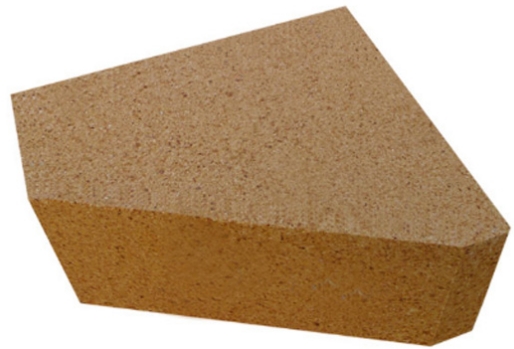- 01
- Oct
Clay arch brick
Clay arch brick

1. The arch-foot clay bricks are made of 50% soft clay and 50% hard clay clinker, mixed according to a certain particle size requirement, and after molding and drying, they are fired at a high temperature of 1300 to 1400 ℃. Clay refractory bricks are weakly acidic refractory products, which can resist the erosion of acid slag and acid gas, and have a slightly weaker resistance to alkaline substances. Clay bricks have good thermal properties and are resistant to rapid cold and rapid heat.
The clay refractory bricks produced by our company are based on the production of ordinary clay bricks, using high-quality homogenizing materials as the main raw materials, adding appropriate amounts of auxiliary materials and some additives, after fine grinding, mixing, and high-pressure molding, and then properly fired It transforms into mullite crystal phase at temperature, and the residual product has a good mineral composition, so as to ensure that the clay refractory brick has high refractoriness, dense bulk density, low porosity, excellent high temperature creep performance and good volume stability .
1. Refractoriness: The refractoriness of general clay bricks is 1580~1730℃.
2. Load softening temperature: Because clay bricks have a liquid phase at a lower temperature and begin to soften ratio, they will deform if exposed to external forces, so the load softening temperature of clay bricks is much lower than the refractoriness, only about 1350℃.
3. Slag resistance: Clay bricks are weakly acidic refractory materials. They can resist the erosion of acid slag, but their resistance to alkaline slag is slightly weaker.
4. Thermal stability: The thermal expansion coefficient of clay brick is small, so its thermal stability is good. The number of water cooling at 850°C is generally 10 to 15 times.
5. Volume stability: Clay bricks will recrystallize at high temperatures, which reduces the volume of the bricks. At the same time, a liquid phase is produced. Due to the surface tension of the liquid phase, the solid particles are close to each other, the porosity is low, and the volume of the brick is reduced. Therefore, the clay brick has the property of residual shrinkage at high temperature. ,
2. The main purpose of clay arch bricks:
1. Clay bricks are mainly used for clay brick building, blast furnaces, hot blast stoves, iron furnaces, open furnaces and electric furnaces, where clay bricks are used in lower temperature parts. Clay bricks are used for steel drums, bricks for casting systems, heating furnaces, heat treatment furnaces, combustion chambers, flues, chimneys, etc. Clay bricks are especially suitable for parts with large temperature changes.
2. Clay bricks are weakly acidic refractory products, which can resist the erosion of acidic slag and acid gas, and have a slightly weaker resistance to alkaline substances. Clay bricks have good thermal properties and are resistant to rapid cold and rapid heat.
3. The refractoriness of clay bricks is comparable to that of silica bricks, up to 1690~1730℃, but the softening temperature under load is more than 200℃ lower than that of silica bricks. Because the clay brick contains mullite crystals with high refractoriness, it also contains nearly half of the low melting point amorphous glass phase.
4. In the temperature range of 0~1000℃, the volume of clay bricks expands uniformly with the increase of temperature. The linear expansion curve is approximate to a straight line, and the linear expansion rate is 0.6%~0.7%, which is only about half of that of silica bricks. When the temperature reaches 1200 ℃ and then continue to increase, its volume will start to shrink from the expansion value. The residual shrinkage of the clay bricks leads to the loosening of the mortar joints of the masonry, which is a major disadvantage of the clay bricks. When the temperature exceeds 1200°C, the low melting point substances in the clay bricks gradually melt, and the particles are tightly pressed against each other due to surface tension, resulting in volume shrinkage.
5. Due to the low load softening temperature of clay bricks, it shrinks at high temperatures, and its thermal conductivity is 15%-20% lower than that of silica bricks, and its mechanical strength is also worse than that of silica bricks. Therefore, clay bricks can only be used for the secondary purpose of coke ovens. Parts such as the sealing wall of the regenerator, small flue lining bricks and checker bricks for the regenerator, furnace door lining bricks, furnace roof and riser lining bricks, etc.
3. Clay refractory products:
1. The products are divided into three grades (NZ)-42, (NZ)-40 and (NZ)-38 according to physical and chemical indicators.
2. The classification of the product conforms to the provisions of YB844-75 “Type and Definition of Refractory Products”. Generally divided into standard type, general type, special type, special type, and can also be specially made according to user requirements.
3. The shape and size of the product meet the requirements of GB2992-82 “General Refractory Brick Shape and Size”. If there is no brick type required by the buyer in the standard, it will be produced according to the buyer’s drawings.
4. T-38 clay brick size: 230*114*65/55
Application of arch-foot clay bricks: Mainly used in thermal boilers, glass kilns, cement kilns, fertilizer gas furnaces, blast furnaces, hot blast furnaces, coking furnaces, electric furnaces, bricks for casting and pouring steel, etc.
Physical and chemical indicators:
| Rank/Index | —级粘土砖 | 二级粘土砖 |
| N-1 | N-2 | |
| AL203 | 55 | 48 |
| Fe203% < | 2.8 | 2.8 |
| Bulk density g/cm2 | 2.2 | 2.15 |
| Compressive strength with temperature MPa> | 50 | 40 |
| Load softening temperature °C | 1420 | 1350 |
| Time magnanimity °C> | 1790 | 1690 |
| Apparent porosity% < | 26 | 26 |
| Heating permanent line change rate% | -0.3 | -0.4 |
